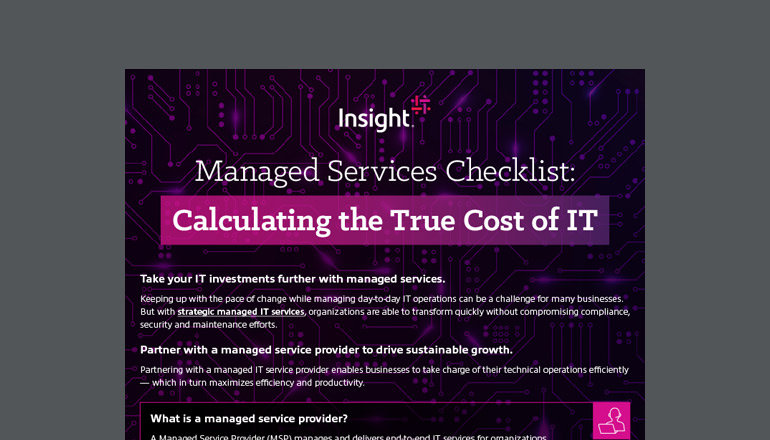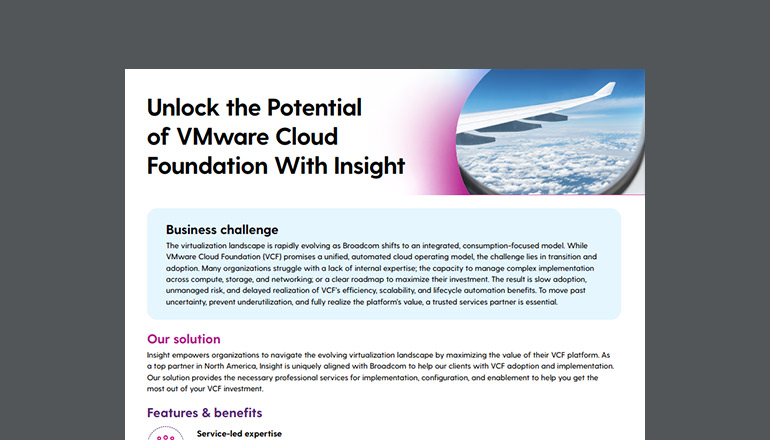Blog 5 Ways Managed Infrastructure Services Help You Meet Key Priorities
By Phil O'Konski / 26 Sep 2023 / Topics: As a service Digital transformation

1. Staff retention: Access to a skilled team
Keeping up with rapidly evolving technologies while ensuring staff members are trained and up to date can be demanding. We see many systems that require 24/7 monitoring and support — which means having staff on hand at all times (including nights, weekends and holidays).
Managing shifts, ensuring proper handover procedures and fostering a healthy work-life balance can be a lot to juggle. With managed infrastructure services, you gain access to a highly skilled team of professionals who can monitor, manage and support your infrastructure around the clock. This relieves the burden of staffing challenges, ensuring consistent expertise and support for your operations.
2. Accelerating projects: Renewing focus on strategic initiatives
Ongoing operational duties can take a hefty portion of an IT team's time and attention — creating roadblocks to innovation with limited resources available for strategic initiatives.
By outsourcing the day-to-day operational burden to a managed infrastructure services provider, internal resources can concentrate on strategic projects and driving innovation — even upskilling IT teams. Making headway on bigger-picture initiatives means ensuring a strategic balance between maintaining existing systems while also pursuing forward-thinking projects.
Building a powerhouse
Cornerstone Bulding Brands — the largest building products manufacturer in the U.S. — leans on Insight to help run their infrastructure service offerings as part of a much broader transformation plan. Hear its leadership talk about the company's strategic objectives in this video.
3. Cost-efficiency: Stable and predictable costs
Managing your infrastructure in house can be costly. In-house infrastructure management often means you need to anticipate and provision resources based on peak demand, which can lead to overprovisioning or underutilization of infrastructure. Overprovisioning results in wasted resources; underutilization means paying for idle infrastructure.
Managed Services Checklist:
Calculating the True Cost of IT
With managed services, businesses benefit from stable and predictable costs afforded by OpEx models. For managed service providers to be competitive, automation must be included. Additionally, organizations can eliminate the need for extensive internal IT teams — reducing expenses related to training, recruitment, management and much more. Why invest in operational innovation activities when a partner must include it as a core of their business to show ongoing value to their clients?
4. Enhancing service levels with proactive support
If your infrastructure maintenance is falling short for any reason — be it limitations with patching, resilience, monitoring and visibility, cost, scale or skills — it can lead to performance issues and service disruptions. Managed services offer 24/7 coverage and proactive monitoring to improve response time and enhance service levels. By relying on the expertise of a service provider, you can ensure optimal systems’ patch levels and performance, improved availability and better performance metrics.
At Insight, we take Service-Level Agreements (SLAs) seriously for our clients — including financial penalties that drive focus and success in this area. Our monthly CSAT evaluation (where our service delivery manager compiles CSAT scores and feedback for in-depth analysis and trends) is just one example of that commitment.
At a glance: Real-World Success With Managed Services
Explore examples and use cases of managed services — and how real clients are driving transformation from the data center to the network, cloud and beyond.
5. Continuous improvement in IT operations
While service levels define the desired outcomes or expectations, IT operations evolve the overall way your business is functioning to meet those expectations. Managed services can help you exceed those expectations.
Managed service providers can leverage performance tuning, strategic workload alignment and balancing, and resource optimization techniques to ensure an organization’s infrastructure operates at its peak. By continuously evaluating and fine-tuning the environment, companies can pinpoint areas of improvement, streamline processes and eliminate bottlenecks — improving IT operations overall.
What potential will your organization unlock?
It’s worth noting that in our annual research survey on digital transformation, the No. 1 initiative for 2023 is optimizing IT infrastructure, according to business leaders. In fact, 84% are using or have definite plans to use third-party providers over the next 12 months to enable digital transformation. And infrastructure optimization is also the initiative that’s expected to drive the most impact for innovation and revenue generation (one great example of innovation in this space is AI-powered infrastructure).
It’s my view that organizations can’t optimize what they can’t first manage — and managed infrastructure has been a great way to build the foundation for what’s next.
Driving Innovation Across the Business:
The Power of Managed ServicesYour biggest goals are within reach. Discover high-value, high-performance Managed Services from Insight.







